If you’ve received a Request for Evidence (RFE) from U.S. Citizenship and Immigration Services (USCIS), don’t panic. An RFE is not a denial—it’s a second chance to strengthen your application. But it’s critical that you respond properly and on time.
This guide explains what an RFE means, why you received it, and exactly how to respond to give your case the best chance of approval.
What Is an RFE and Why Did You Get One?
A Request for Evidence is a formal notice from USCIS asking for more information or documentation before they can make a decision on your application. It usually means one of two things:
- You left something out of your original filing
- The evidence you submitted was incomplete, unclear, or insufficient
RFEs are common with these types of applications:
- Green card (Form I-485 or consular processing)
- Work permits (Form I-765)
- Marriage-based petitions (Form I-130)
- Affidavit of Support (Form I-864)
- Citizenship (Form N-400)
- Employment-based visas
Common Reasons USCIS Sends an RFE
Here are some of the most frequent triggers for an RFE:
- Missing supporting documents (birth certificate, passport copy, marriage certificate)
- Incomplete or outdated Form I-864
- Insufficient proof of a bona fide marriage
- Conflicting information across forms
- Lack of translation for foreign-language documents
- Medical exam expired or missing
Tip: Always double-check the official checklist for your form before you file to avoid RFEs in the first place.
How to Read and Understand the RFE Notice
An RFE will arrive in the mail as a physical letter. The format is consistent and includes:
- A list of missing or insufficient items
- Instructions on what to submit
- Deadline for submission (usually 30–87 days)
Do not ignore the deadline. USCIS must receive your response by the stated due date—not postmarked, received.
Also, take note of the Form number and receipt number referenced. This helps you ensure the response matches the correct case.
Steps to Respond to an RFE (Correctly)
1. Read the RFE Carefully
Don’t rush. Highlight the exact documents or information USCIS wants. Misunderstanding their request could delay or harm your case.
2. Gather the Requested Evidence
Make sure your documents are:
- Clear and legible
- Properly translated (with certification if not in English)
- Accurate and up to date
Include originals or copies based on what USCIS specifically asks for. If they want a copy, sending an original could cause issues.
3. Write a Cover Letter
Although not always required, a simple cover letter helps organize your response. It should include:
- Applicant name, date of birth, and receipt number
- A short summary of what you’re submitting
- A checklist matching each requested item to the evidence provided
4. Make Copies of Everything
Keep a full copy of your response for your records. If USCIS misplaces your file, you’ll be glad you did.
5. Send the Response to the Right Address
USCIS typically provides a specific address for RFE responses. Use the envelope included with the RFE, or match the address on the letter exactly.
Use a traceable delivery method like USPS Priority Mail, FedEx, or UPS with tracking. Always get a receipt.
What Happens After You Submit the RFE?
Once your RFE response is received and processed, USCIS resumes work on your application. The wait time varies, but here’s what usually happens:
- You may get a case update online within 1–4 weeks: “RFE Response Received”
- If all goes well, you’ll get a decision (approval or next step) in 60–90 days
- If the RFE was not satisfied, you may receive a second RFE, Notice of Intent to Deny (NOID), or denial
Real-World Example: Marriage-Based RFE
Let’s say you filed Form I-130 for your spouse and forgot to include a copy of your marriage certificate and joint lease. USCIS sends an RFE asking for:
- Proof of legal marriage
- Evidence of shared residence and relationship history
Your response should include:
- Certified copy of marriage certificate
- Joint utility bills, bank statements, lease, or photos
- A short statement confirming the nature of your marriage
Organized properly, this can resolve the RFE and move your petition forward.
USCIS RFE Statistics
- In 2023, nearly 24% of green card applications received an RFE (Source: USCIS.gov)
- Marriage-based petitions had one of the highest RFE rates—up to 40%
- USCIS typically gives 87 days to respond, but only one chance—no extensions allowed
FAQs About USCIS RFEs
1. Does receiving an RFE mean I’m likely to be denied?
Not at all. RFEs are often procedural. Many applicants receive an RFE and still get approved.
2. Can I send extra documents that weren’t requested?
Yes, but only if they directly support your case. Don’t overload the file with irrelevant info.
3. What if I don’t understand what USCIS is asking for?
You can consult a qualified immigration attorney or community nonprofit. Avoid guessing—an incorrect response could harm your case.
4. Can I get more time to respond?
No. The deadline is fixed. USCIS will not grant extensions.
5. What happens if I ignore the RFE?
Your application will be denied for abandonment. Always respond on time.
Final Thoughts: Responding to an RFE the Smart Way
An RFE is not the end—it’s your chance to fix the issue and strengthen your case. The key is to:
- Read carefully
- Stay organized
- Submit exactly what’s asked
- Send it on time
Handled properly, your RFE response can turn a shaky application into an approved one. Use it as a second shot—and make it count.



